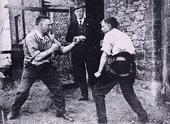I am the first western form of fighting to exist that is present in modern Mixed Martial Arts leagues existing today such as UFC and Pride. I came before modern boxing and the skills and techniques found in Bare Knuckle fights are some of the most prominent in MMA today.
Striking with the fist as an organized sport came to the British Isles in 43 C.E. with the Roman invasion. The Romans adopted the Greek Olympic sport and created even more brutal versions of their own often involving the use of studded gauntlets. The sport of boxing left the British Isles with the last of the Roman legions in 436 C.E. and did not reappear for almost 1300 years.
In the second decade of the 1700's, the premier fencer in England was James Figg. He was considered to be the national champion of backsword and quarterstaff which he taught at his Fighting Academy on Tottenham Court Road in London. It was at this Fighting Academy that Figg devised his method of "fencing with the fists" and in 1719, declared himself to be the Bare-Knuckle Champion of England. He defended this title against several challengers including his arch rival Ned Sutton whom he defeated with fists, staff, and sword.
Before coming to America, common Bare Knuckle Boxing techniques included head butting, knee strikes, and neck throttling, which included choking, head locking and neck cranking.
There was also an adjunct rule about not using the ropes to your advantage, all chatacyeristics of MMA today.
The first official boxing match in America took place in New York City in 1816. Dutchman Jacob Hyer defeated Tom Beasley in the only match that either of them fought. Thirty-three years later, Jacob's son, Tom Hyer, won the first American Championship when he defeated small-time criminal, James Ambrose, who fought as "Yankee Sullivan."
Bare-knuckle pugilism may have reached its height as an art form under the London Prize Ring Rules. Due to the limitation of brawling techniques, more boxers began to learn the Scientific Style that was developed by Daniel Mendoza. Many fighters began to add the art of Cornish Wrestling to the Mendoza Scientific Style. This style of wrestling perfectly adapted to the new rules of boxing. It developed through centuries of competition with its rival of English Westlands Wrestling, the Devonshire Style.
Traditionally the Devon men were known as the "kickers and trippers," while the Cornish men were known for their "hugging and heaving." Techniques of Cornish Wrestling consisted mostly of upper body throwing techniques, because it was a standing style in which a throw constituted a win. All the old Celtic styles of wrestling ended in this fashion, because the Celts considered ground grappling to be unmanly. Bare-knuckle Boxers favored a type of spring hip throw, in which they followed their opponent down, landing their full weight on his abdomen. This technique was called a "Cross Buttock." Another favorite technique under the London Prize Ring Rules was to "Seize and Fib," grabbing and pulling in your opponent with one hand while delivering short punches with the other hand.
The spinning backfist was also a common technique and was called the "Pivot Punch." When a bare-knuckle fighter added the sweeps and low kicks of Devonshire Wrestling to his arsenal he was in command of a practical fighting system. This mixture of striking and grappling brought boxing to its highest level as a complete martial art.
